Milling Stability Modeling by Sample Partitioning with Chatter Frequency-Based Test Point Selection
Abstract
:1. Introduction
2. Sample Partitioning
2.1. Frequency Domain Stability Model
2.2. Modal Parameters
2.3. Cutting Force Model
2.4. Sample Partitioning Algorithm
2.5. Case Study
3. Discussion
4. Conclusions
Funding
Data availability statement
Conflicts of Interest
References
- Altintas, Y.; Stepan, G.; Budak, E.; Schmitz, T.; Kilic, Z.M. Chatter stability of machining operations. ASME J. Manuf. Sci. Eng. 2020, 142, 110801. [Google Scholar] [CrossRef]
- Ewins, D.J. Modal Testing: Theory, Practice and Application; John Wiley & Sons: Hoboken, NJ, USA, 2009. [Google Scholar]
- Schmitz, T.; Smith, K.S. Machining Dynamics: Frequency Response to Improved Productivity, 2nd ed.; Springer: Berlin/Heidelberg, Germany, 2019. [Google Scholar]
- Kim, H.S.; Schmitz, T.L. Bivariate uncertainty analysis for impact testing. Meas. Sci. Technol. 2007, 18, 3565. [Google Scholar] [CrossRef]
- Altintas, Y. Manufacturing Automation: Metal Cutting Mechanics, Machine Tool Vibrations, and CNC Design; Cambridge University Press: Cambridge, UK, 2000. [Google Scholar]
- Altintas, Y.; Budak, E. Analytical prediction of stability lobes in milling. CIRP Ann. 1995, 44, 357–362. [Google Scholar] [CrossRef]
- Campomanes, M.L.; Altintas, Y. An improved time domain simulation for dynamic milling at small radial immersions. J. Manuf. Sci. Eng. 2003, 125, 416–422. [Google Scholar] [CrossRef]
- Denkena, B.; Grabowski, R.; Krödel, A.; Ellersiek, L. Time-domain simulation of milling processes including process damping. CIRP J. Manuf. Sci. Technol. 2020, 30, 149–156. [Google Scholar] [CrossRef]
- Altintas, Y.; Stépán, G.; Merdol, D.; Dombóvári, Z. Chatter stability of milling in frequency and discrete time domain. CIRP J. Manuf. Sci. Technol. 2008, 1, 35–44. [Google Scholar] [CrossRef]
- Kahraman, M.F.; Bilge, H.; Öztürk, S. Uncertainty analysis of milling parameters using Monte Carlo simulation, the Taguchi optimization method and data-driven modeling. Mater. Test. 2019, 61, 477–483. [Google Scholar] [CrossRef]
- Gul, E.; Joseph, V.R.; Yan, H.; Melkote, S.N. Uncertainty quantification of machining simulations using an in situ emulator. J. Qual. Technol. 2018, 50, 253–261. [Google Scholar] [CrossRef]
- Madić, M.; Radovanović, M. Possibilities of using Monte Carlo method for solving machining optimization problems. Facta Univ. Ser. Mech. Eng. 2014, 12, 27–36. [Google Scholar]
- Delio, T.; Tlusty, J.; Smith, S. Use of audio signals for chatter detection and control. ASME J. Eng. Ind. 1992, 114, 146–157. [Google Scholar] [CrossRef]
- Maamar, A.; Le, T.P.; Gagnol, V.; Sabourin, L. Modal identification of a machine tool structure during machining operations. Int. J. Adv. Manuf. Technol. 2019, 102, 253–264. [Google Scholar] [CrossRef]
- Gagnol, V.; Le, T.P.; Ray, P. Modal identification of spindle-tool unit in high-speed machining. Mech. Syst. Signal Process. 2011, 25, 2388–2398. [Google Scholar] [CrossRef]
- Zaghbani, I.; Songmene, V. Estimation of machine-tool dynamic parameters during machining operation through operational modal analysis. Int. J. Mach. Tools Manuf. 2009, 49, 947–957. [Google Scholar] [CrossRef]
- Wang, M.; Gao, L.; Zheng, Y. An examination of the fundamental mechanics of cutting force coefficients. Int. J. Mach. Tools Manuf. 2014, 78, 1–7. [Google Scholar] [CrossRef]
- Altintas, Y.; Eynian, M.; Onozuka, H. Identification of dynamic cutting force coefficients and chatter stability with process damping. CIRP Ann. 2008, 57, 371–374. [Google Scholar] [CrossRef]
- Campatelli, G.; Scippa, A. Prediction of milling cutting force coefficients for Aluminum 6082-T4. Procedia CIRP 2012, 1, 563–568. [Google Scholar] [CrossRef]
- Popović, M.; Tanović, L.; Ehmann, K.F. Cutting forces prediction: The experimental identification of orthogonal cutting coefficients. FME Trans. 2017, 45, 459–467. [Google Scholar] [CrossRef]
- von Hahn, T.; Mechefske, C.K. Machine Learning in CNC Machining: Best Practices. Machines 2022, 10, 1233. [Google Scholar] [CrossRef]
- Insperger, T.; Stépán, G.; Bayly, P.V.; Mann, B.P. Multiple chatter frequencies in milling processes. J. Sound Vib. 2003, 262, 333–345. [Google Scholar] [CrossRef]
- Cramér, H. Random Variables and Probability Distributions; Cambridge University Press: Cambridge, UK, 2004. [Google Scholar]
- Tekeli, A.; Budak, E. Maximization of chatter-free material removal rate in end milling using analytical methods. Mach. Sci. Technol. 2005, 9, 147–167. [Google Scholar] [CrossRef]
- Honeycutt, A.; Schmitz, T.L. Milling stability interrogation by subharmonic sampling. J. Manuf. Sci. Eng. 2017, 139, 041009. [Google Scholar] [CrossRef]
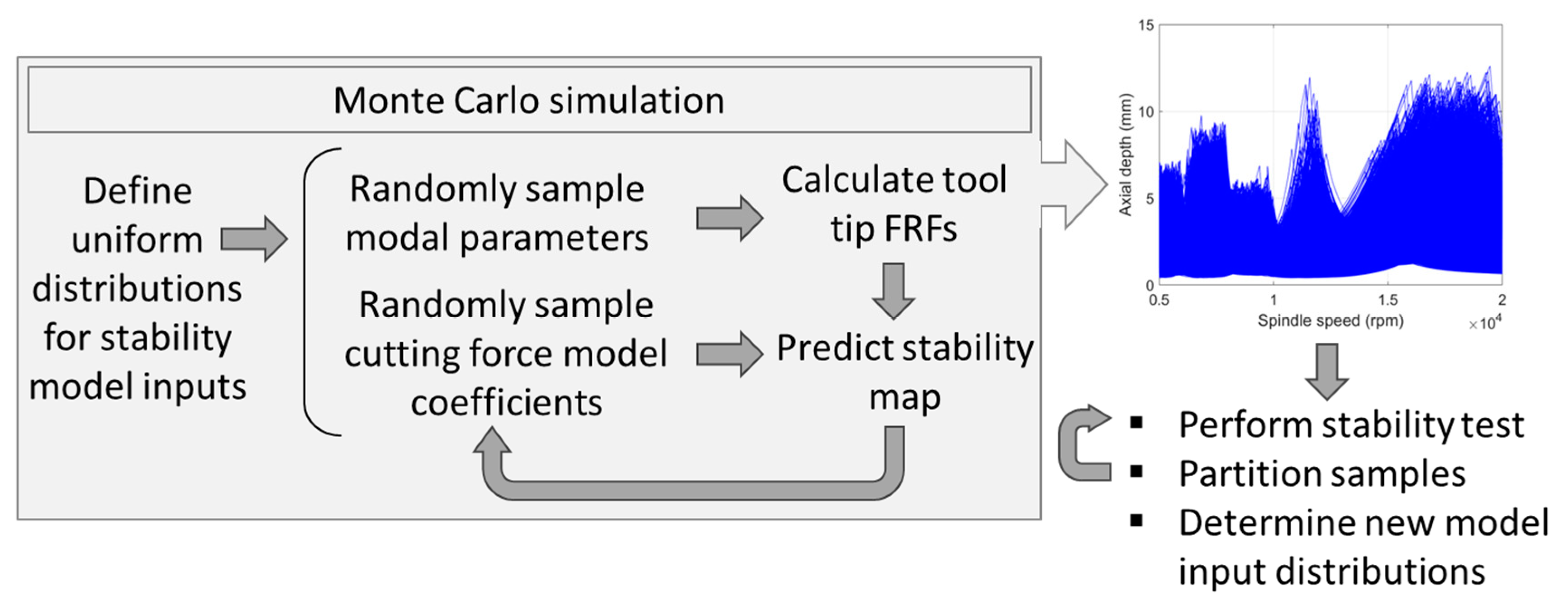
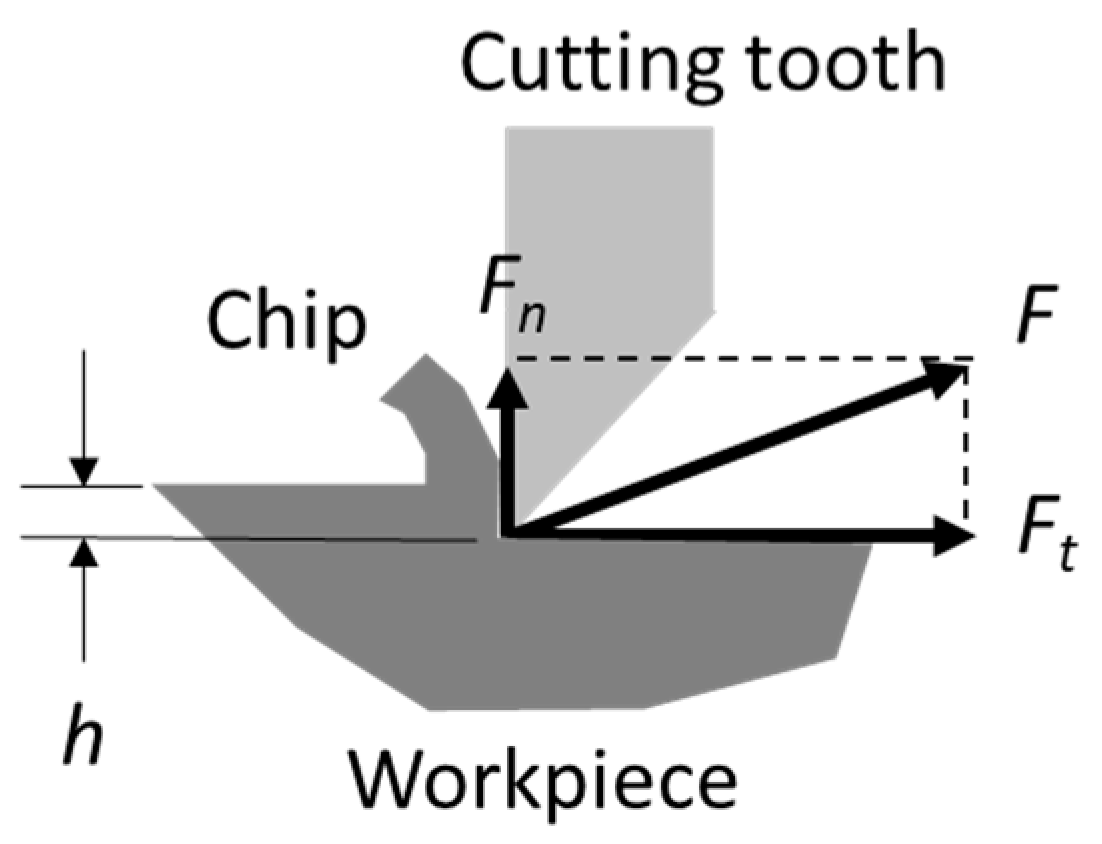

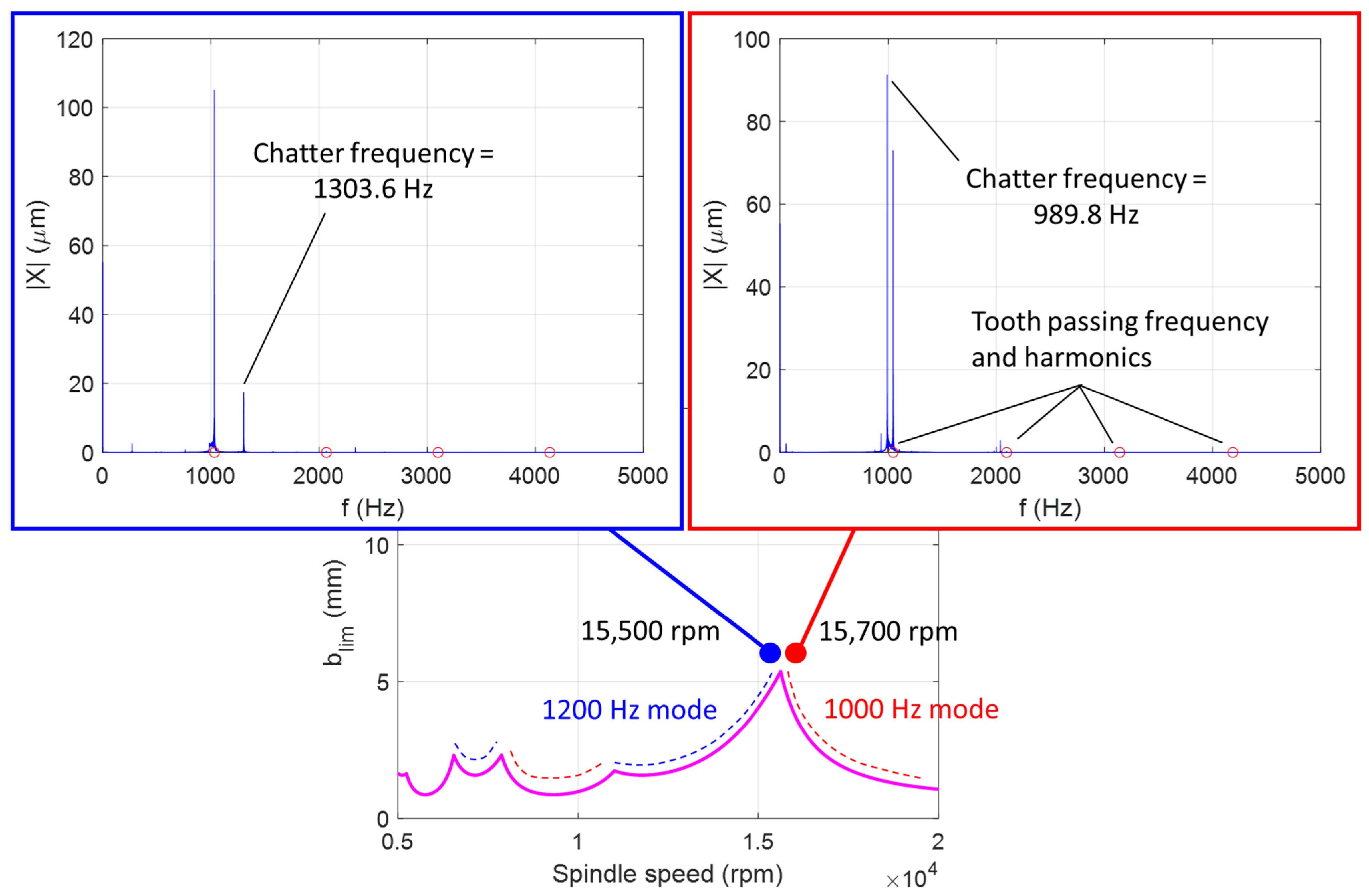

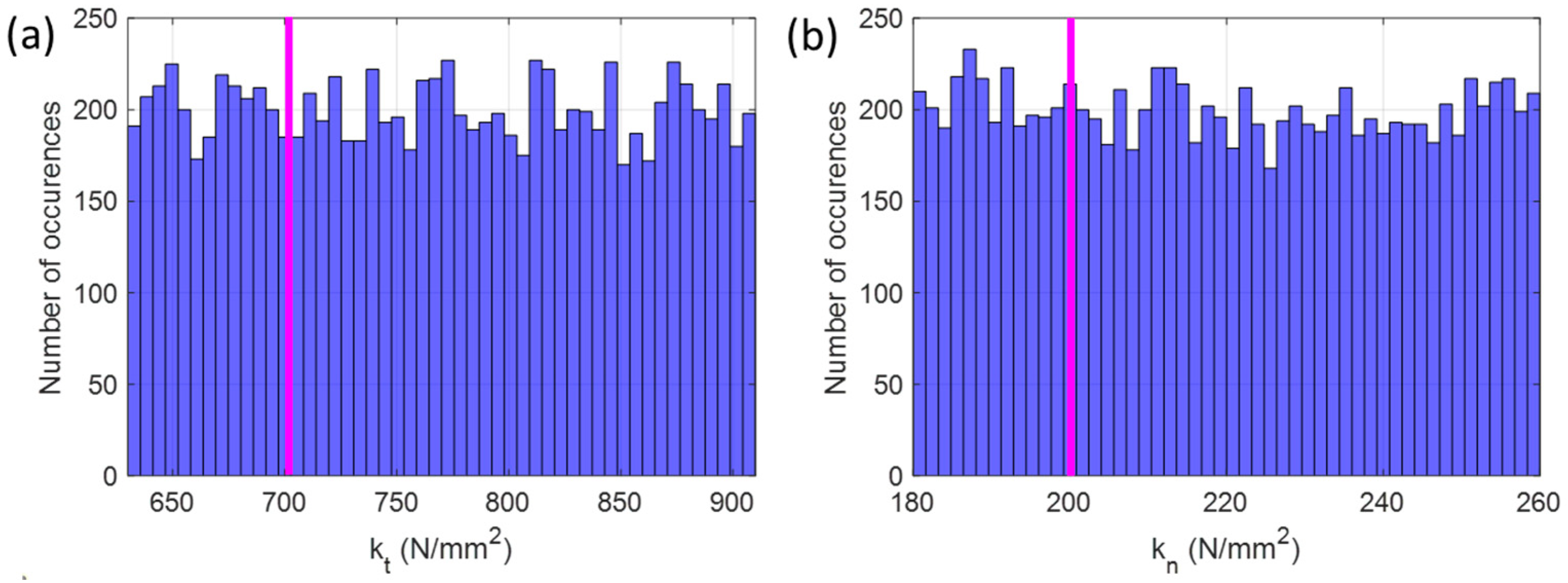
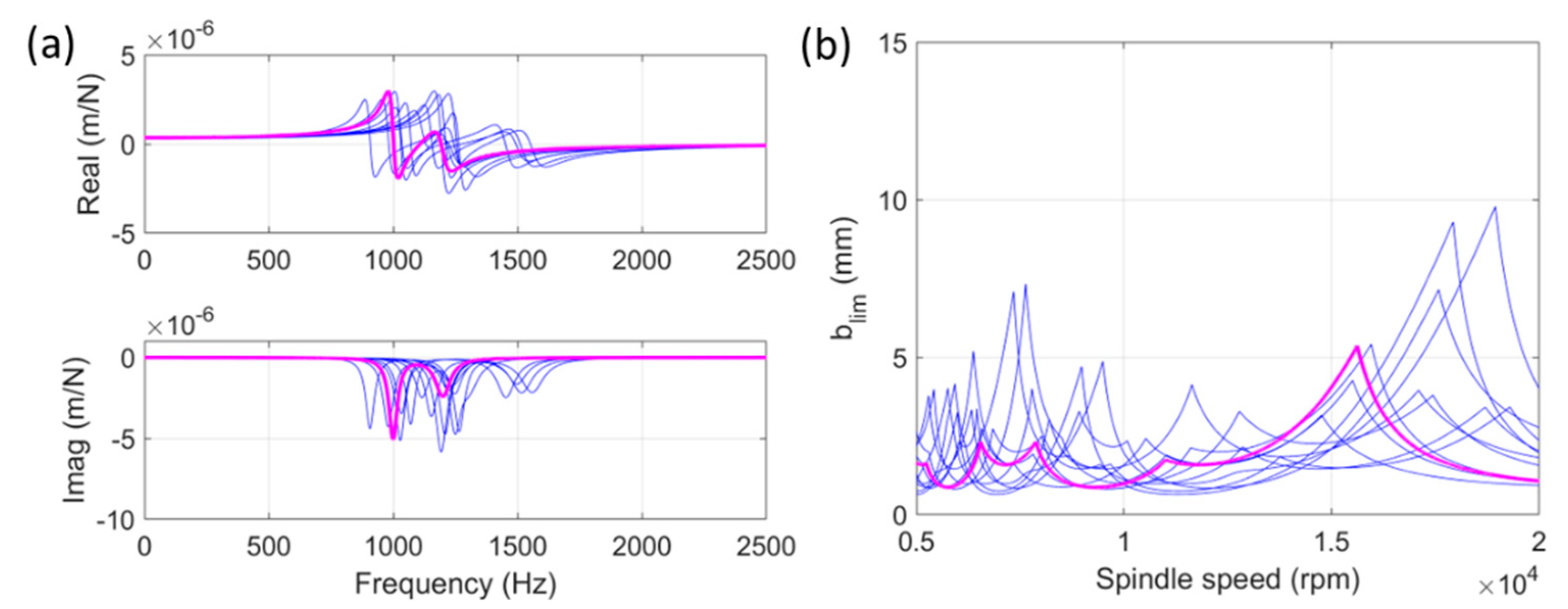

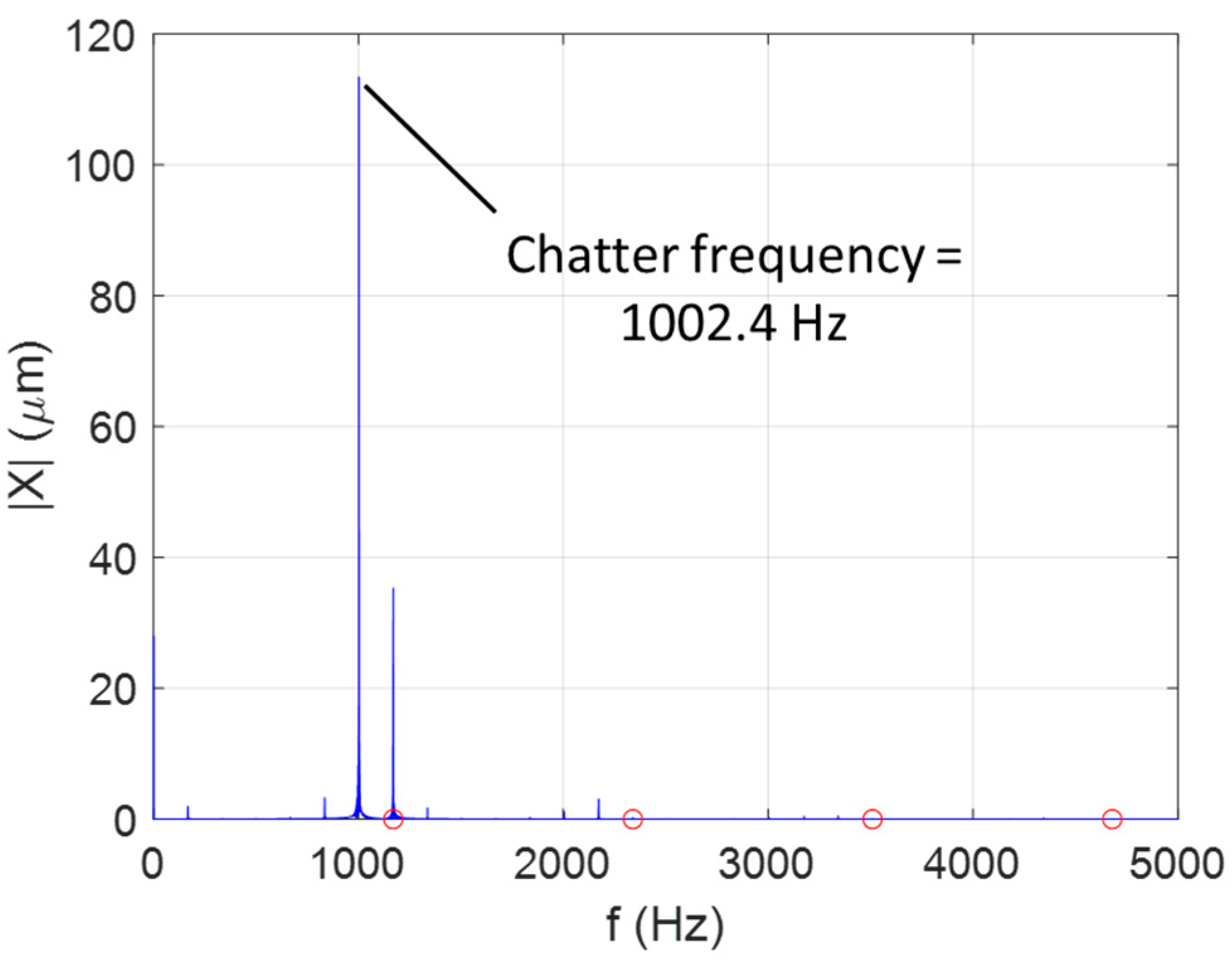
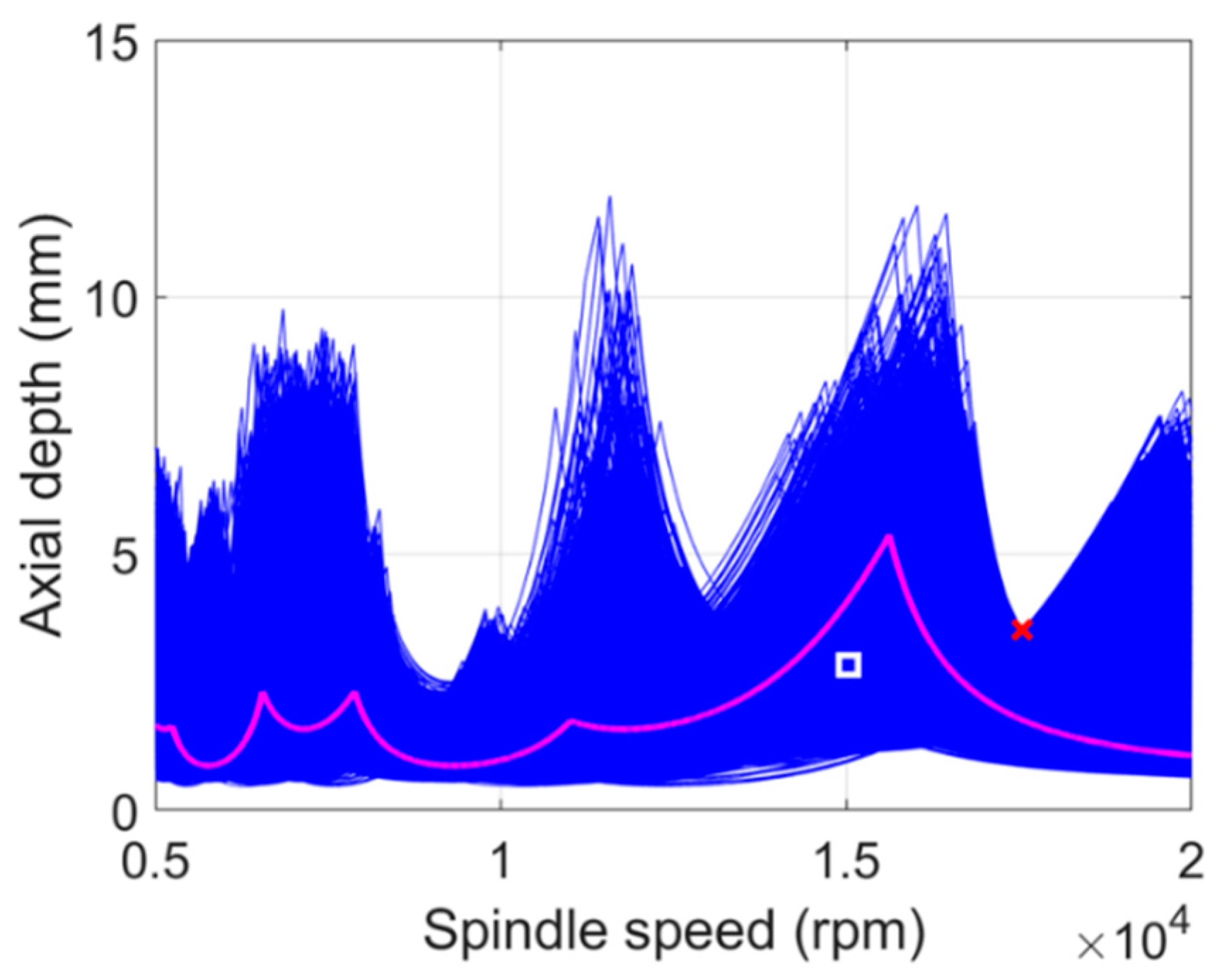
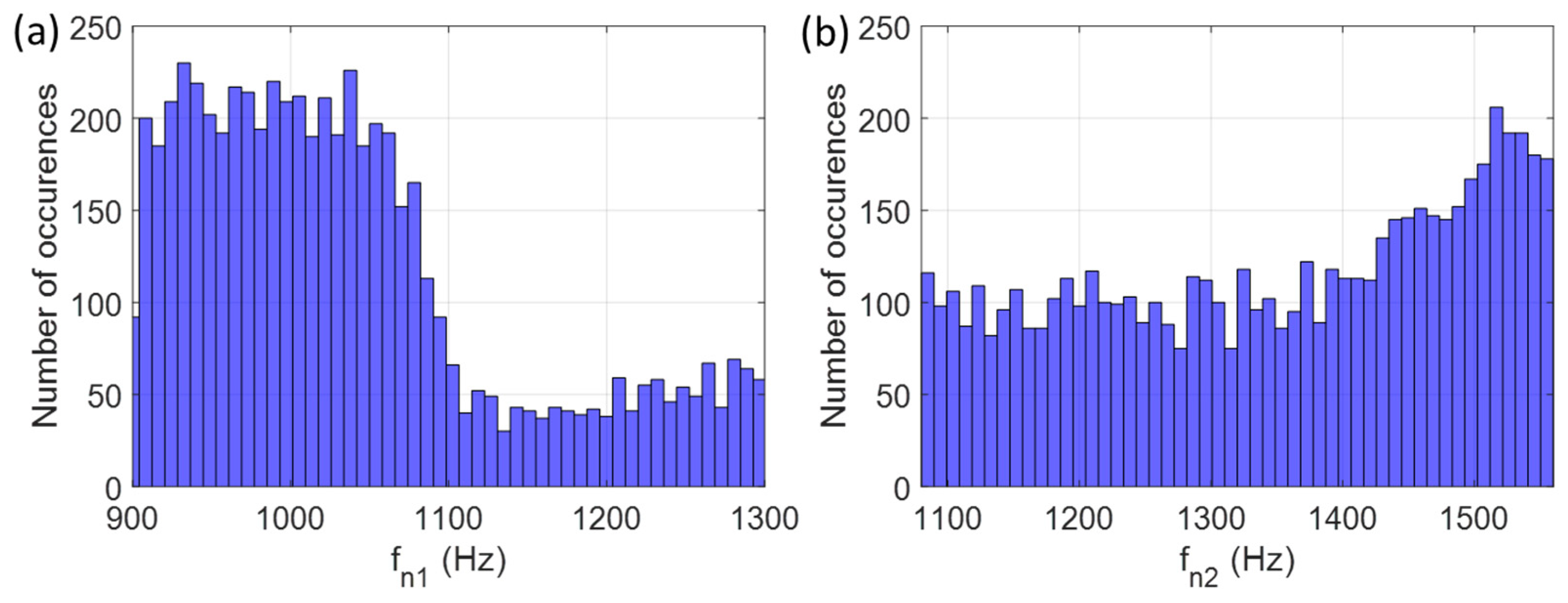
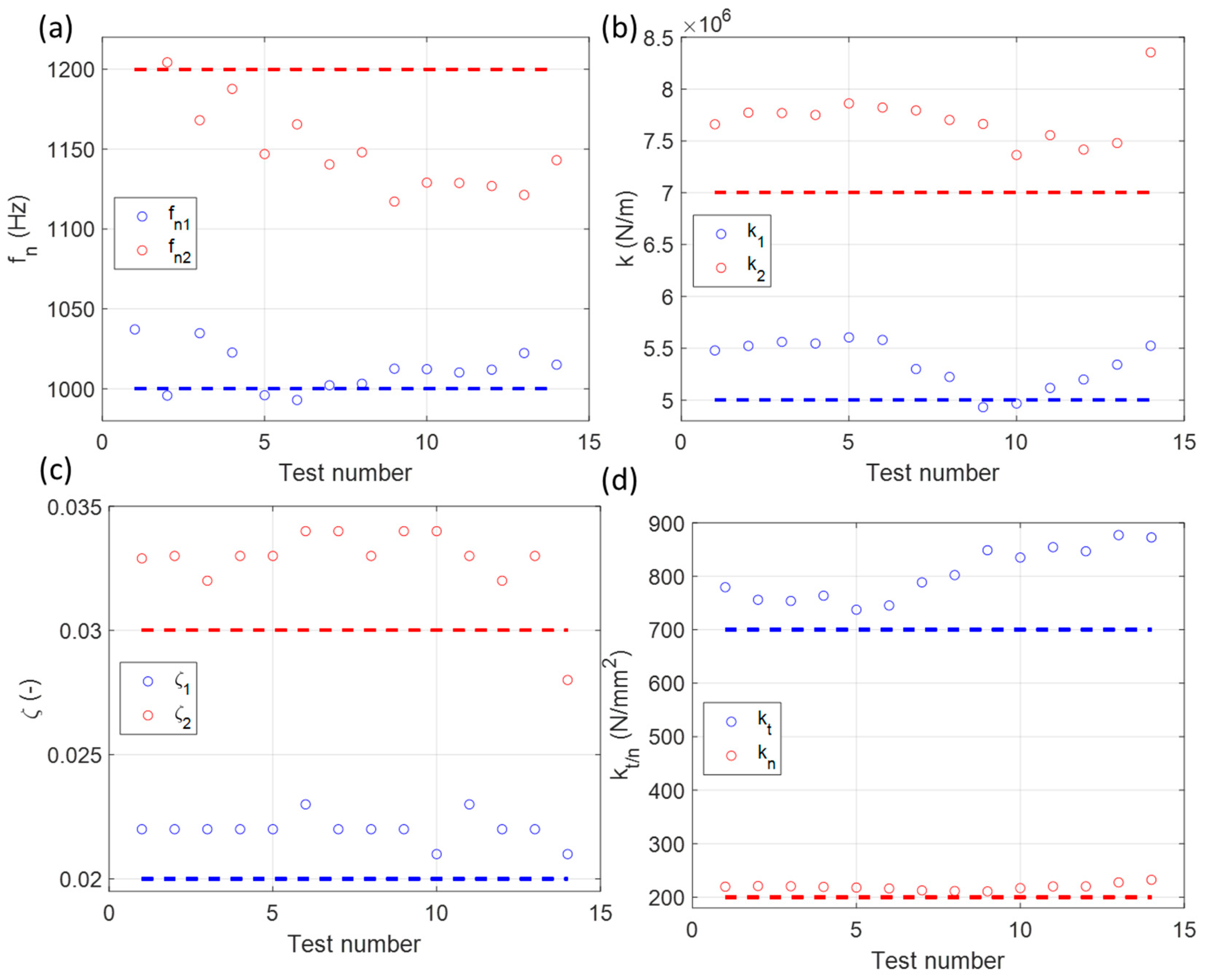
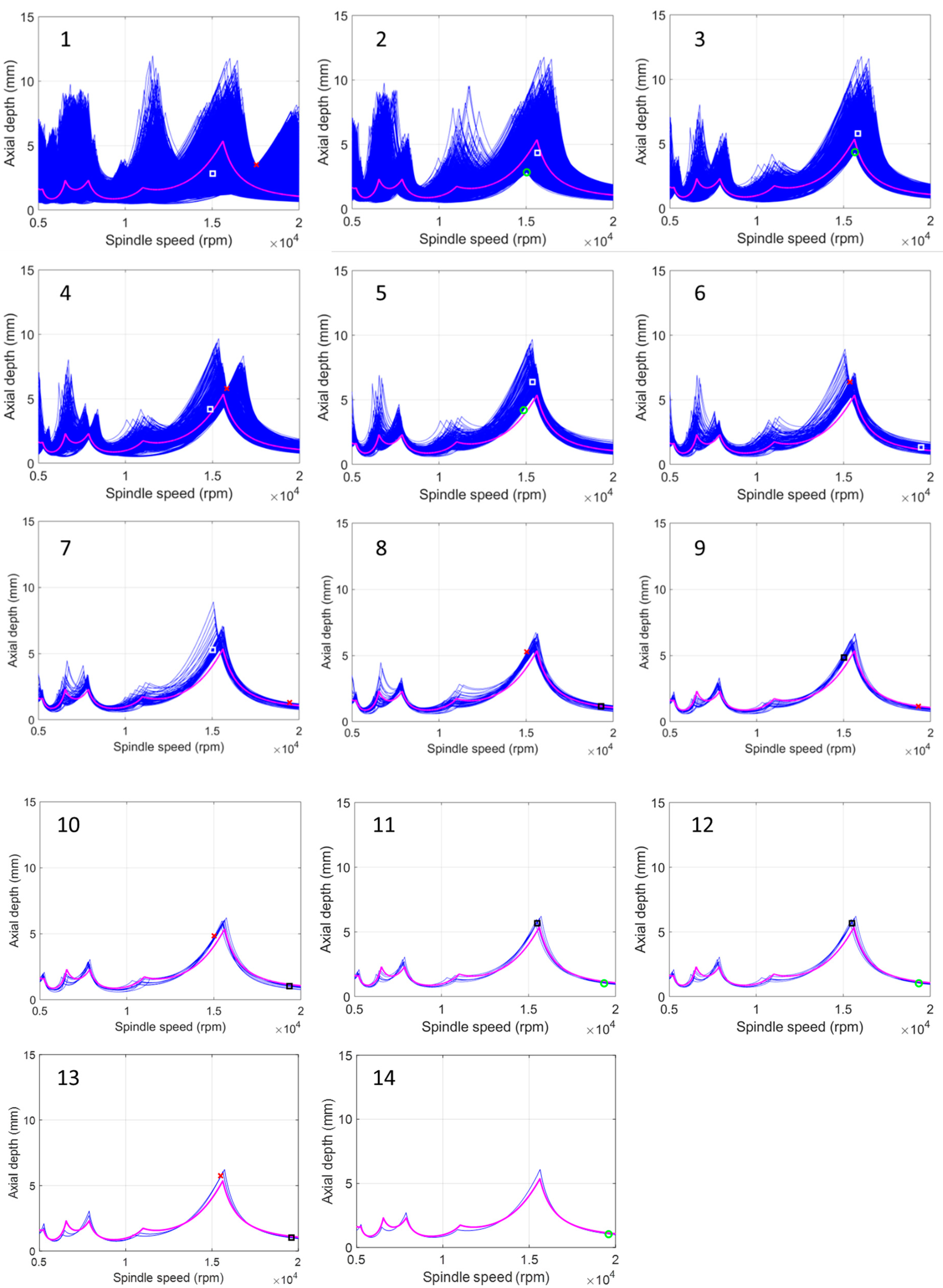

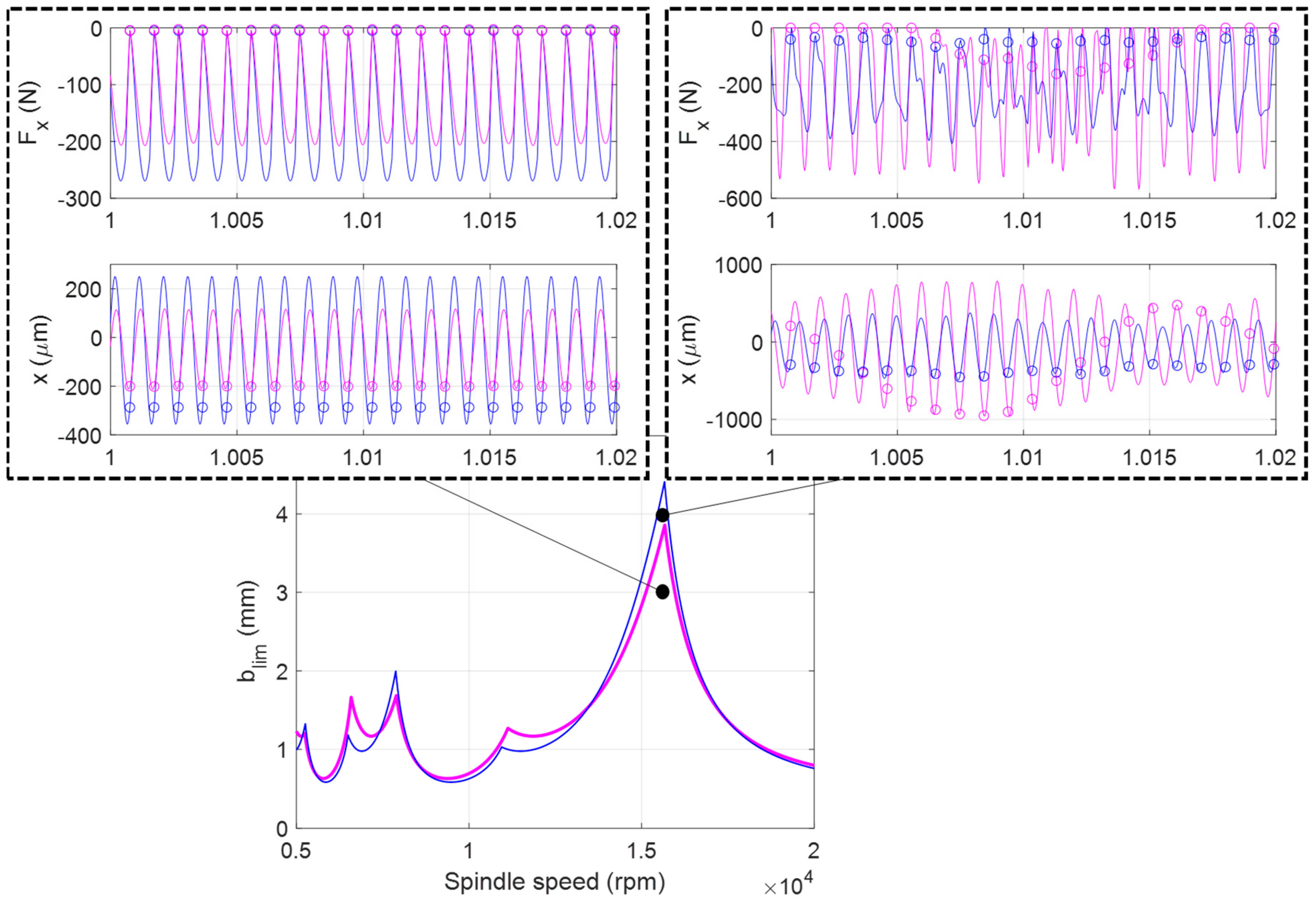
| Modal Parameters | |||
| fn1 (Hz) | 1000 | fn2 (Hz) | 1200 |
| k1 (N/m) | 5 × 106 | k2 (N/m) | 7 × 106 |
| ζ1 (-) | 0.02 | ζ2 (-) | 0.03 |
| Cutting force model coefficients | |||
| kt (N/mm2) | 700 | ||
| kn (N/mm2) | 200 | ||
| Test Number | Spindle Speed (rpm) | Axial Depth (mm) | Number of Samples Remaining | Result (Stable or Unstable) | Chatter Frequency (Hz) |
|---|---|---|---|---|---|
| 1 | 17,547 | 3.5082 | 5933 | U | 1002.4 |
| 2 | 15,036 | 2.8313 | 2284 | S | - |
| 3 | 15,652 | 4.3462 | 996 | S | - |
| 4 | 15,823 | 5.7928 | 579 | U | 990.6 |
| 5 | 14,859 | 4.1948 | 202 | S | - |
| 6 | 15,356 | 6.3741 | 117 | U | 1297 |
| 7 | 19,455 | 1.3065 | 61 | U | 1002.3 |
| 8 | 15,035 | 5.2794 | 39 | U | 1287 |
| 9 | 19,305 | 1.1535 | 17 | U | 1001.4 |
| 10 | 15,021 | 4.8373 | 9 | U | 1289.5 |
| 11 | 19,343 | 1.0234 | 6 | S | - |
| 12 | 15,496 | 5.6584 | 5 | S | - |
| 13 | 15,497 | 5.7520 | 2 | U | 1306.6 |
| 14 | 19,599 | 1.0305 | 1 | S | - |
| Test Number | fn1 (Hz) | k1 × 106 (N/m) | ζ1 (-) | fn2 (Hz) | k2 × 106 (N/m) | ζ2 (-) | kt (N/mm2) | kn (N/mm2) |
|---|---|---|---|---|---|---|---|---|
| 1 | 1037.2 | 5.4789 | 0.022 | 1349.2 | 7.6603 | 0.0329 | 779.44 | 219.79 |
| 2 | 995.8 | 5.5222 | 0.022 | 1204.3 | 7.7727 | 0.033 | 756.03 | 221.05 |
| 3 | 1034.8 | 5.5610 | 0.022 | 1168.1 | 7.7688 | 0.032 | 753.72 | 220.65 |
| 4 | 1022.7 | 5.5458 | 0.022 | 1187.7 | 7.7507 | 0.033 | 763.68 | 219.41 |
| 5 | 996.0 | 5.6043 | 0.022 | 1146.9 | 7.8615 | 0.033 | 737.28 | 218.15 |
| 6 | 993.0 | 5.5804 | 0.023 | 1165.5 | 7.8217 | 0.034 | 745.29 | 216.45 |
| 7 | 1002.2 | 5.2989 | 0.022 | 1140.4 | 7.7941 | 0.034 | 788.66 | 212.84 |
| 8 | 1003.2 | 5.2228 | 0.022 | 1148.0 | 7.7024 | 0.033 | 802.22 | 211.73 |
| 9 | 1012.6 | 4.9311 | 0.022 | 1117.2 | 7.6632 | 0.034 | 848.76 | 211.04 |
| 10 | 1012.3 | 4.9666 | 0.021 | 1129.0 | 7.3640 | 0.034 | 835.10 | 217.16 |
| 11 | 1010.2 | 5.1172 | 0.023 | 1128.8 | 7.5549 | 0.033 | 854.49 | 220.36 |
| 12 | 1012.0 | 5.1983 | 0.022 | 1126.9 | 7.4165 | 0.032 | 846.82 | 220.43 |
| 13 | 1022.4 | 5.3414 | 0.022 | 1121.3 | 7.4793 | 0.033 | 877.17 | 227.77 |
| 14 | 1015.1 | 5.5233 | 0.021 | 1143.1 | 8.3542 | 0.028 | 872.75 | 232.71 |
| Stability Model Input | Post-Partitioning | True | Percent Difference |
|---|---|---|---|
| fn1 (Hz) | 1015.1 | 1000 | 1.51 |
| k1 (N/m) | 5.5233 × 106 | 5 × 106 | 10.47 |
| ζ1 (-) | 0.021 | 0.02 | 5.00 |
| fn2 (Hz) | 1143.1 | 1200 | −4.74 |
| k2 (N/m) | 8.3542 × 106 | 7 × 106 | 19.3 |
| ζ2 (-) | 0.028 | 0.03 | −6.67 |
| kt (N/mm2) | 872.75 | 700 | 24.7 |
| kn (N/mm2) | 232.71 | 200 | 16.4 |
Disclaimer/Publisher’s Note: The statements, opinions and data contained in all publications are solely those of the individual author(s) and contributor(s) and not of MDPI and/or the editor(s). MDPI and/or the editor(s) disclaim responsibility for any injury to people or property resulting from any ideas, methods, instructions or products referred to in the content. |
© 2024 by the author. Licensee MDPI, Basel, Switzerland. This article is an open access article distributed under the terms and conditions of the Creative Commons Attribution (CC BY) license (https://creativecommons.org/licenses/by/4.0/).
Share and Cite
Schmitz, T. Milling Stability Modeling by Sample Partitioning with Chatter Frequency-Based Test Point Selection. J. Manuf. Mater. Process. 2024, 8, 109. https://doi.org/10.3390/jmmp8030109
Schmitz T. Milling Stability Modeling by Sample Partitioning with Chatter Frequency-Based Test Point Selection. Journal of Manufacturing and Materials Processing. 2024; 8(3):109. https://doi.org/10.3390/jmmp8030109
Chicago/Turabian StyleSchmitz, Tony. 2024. "Milling Stability Modeling by Sample Partitioning with Chatter Frequency-Based Test Point Selection" Journal of Manufacturing and Materials Processing 8, no. 3: 109. https://doi.org/10.3390/jmmp8030109





